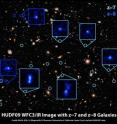Astronomers detect earliest galaxies
Astronomers, using NASA's Hubble Space Telescope, have broken the distance limit for galaxies by uncovering a primordial population of compact and ultra-blue galaxies that have never been seen before. They are from 13 billion years ago, just 600 to 800 million years after the Big Bang. These newly found objects are crucial to understanding the evolutionary link between the birth of the first stars, the formation of the first galaxies, and the sequence of evolutionary events that resulted in the assembly of our Milky Way and the other "mature" elliptical and majestic spiral galaxies in today's universe.
The Hubble Ultra Deep Field 2009 (HUDF09) team combined the new Hubble data with observations from NASA's Spitzer Space Telescope to estimate the ages and masses of these primordial galaxies. "The masses are just 1 percent of those of the Milky Way," explains team member Ivo Labbé of the Carnegie Observatories. He further noted that "to our surprise, the results show that these galaxies existed at 700 million years after the Big Bang and must have started forming stars hundreds of millions of years earlier, pushing back the time of the earliest star formation in the universe."
"With the rejuvenated Hubble and its new instruments, we are now entering unchartered territory that is ripe for new discoveries," says Garth Illingworth of the University of California, Santa Cruz, leader of the HUDF09 survey team that was awarded the time to take the new Wide Field Camera 3 infrared (WFC3/IR) data on the Hubble Ultra Deep Field. The deepest-ever near- infrared view of the universe—the HUDF09 image—has now been combined with the deepest-ever optical image—the original HUDF taken in 2004 with the Advanced Camera for Surveys—to push back the frontier of the search for the first galaxies.
Team member Rychard Bouwens of the University of California, Santa Cruz says that "the faintest galaxies are now showing signs of linkage to the origin of the first stars. They are so blue that they must be extremely deficient in heavy elements, thus representing a population that has nearly primordial characteristics."
The results are gleaned from the HUDF09 observations, which are deep enough at near-infrared wavelengths to reveal galaxies at redshifts from z=7 to beyond redshift z=8. (The redshift value "z" is a measure of the stretching of the wavelength or "reddening" of starlight due to the expansion of space.) The clear detection of galaxies between z=7 and z=8.5 corresponds to "look-back times" of approximately 12.9 billion years to 13.1 billion years ago.
A longstanding question is whether these early galaxies put out enough radiation for "reionization," a phenomenon in which light strips off electrons from the surrounding hydrogen gas. A reonization event occurred between about 400 million and 900 million years after the Big Bang and ended the era referred to as the "dark ages," when the universe, mostly made of hydrogen atoms, was neutral and opaque, and without stars or galaxies.
Astronomers still don't know which sources of light caused reionization to happen or how much light exactly is needed. Several teams are finding that the number of detected galaxies per unit of volume of space drops off smoothly towards earlier times, and that there may be too few of them to ionize the universe. On the other hand, the early galaxies were possibly extraordinarily efficient at emitting ionizing radiation, or perhaps other more exotic phenomena may need to be invoked.
Spectroscopy is needed to provide definitive redshift values, but the newly detected objects are too faint for spectroscopic observations using current telescopes. Currently, the redshifts are inferred by the galaxies' apparent colors through a now very well-established technique. "We are reaching the limit of what we can do with Hubble," says Labbé. "To witness the emergence of the first galaxies requires bigger facilities such as the future James Webb Space Telescope and large telescopes on the ground, such as the planned Giant Magellan Telescope."
Hubble's WFC3/IR camera was able to make deep exposures to uncover new galaxies at roughly 40 times greater efficiency than its earlier infrared camera that was installed in 1997. The WFC3/IR brought new infrared technology to Hubble and accomplished in four days of observing what would have previously taken almost half a year to accomplish.
The WFC3/IR data on the Ultra Deep Field (taken in August 2009) have been analyzed by no less than five international teams of astronomers. A total of 15 papers have been submitted to date by astronomers worldwide. Some of these early results are being presented by various team members on Jan. 6, 2010, at the 215th meeting of the American Astronomical Society in Washington, D.C.
Source: Carnegie Institution
Articles on the same topic
- Hubble finds most distant primeval galaxiesTue, 5 Jan 2010, 16:32:19 UTC
Other sources
- Earliest Known Galaxies Spied in Deep Hubble Picturefrom National GeographicWed, 6 Jan 2010, 17:14:17 UTC
- Hubble Spies Most Distant, Early Galaxies Yetfrom Space.comTue, 5 Jan 2010, 21:21:27 UTC
- Hubble telescope shows earliest photo of universefrom CBC: Technology & ScienceTue, 5 Jan 2010, 21:14:07 UTC
- Hubble Captures Earliest Photo of Universefrom CBSNews - ScienceTue, 5 Jan 2010, 20:35:12 UTC
- Astronomers detect earliest galaxiesfrom Science BlogTue, 5 Jan 2010, 17:42:32 UTC
- Hubble photo shows galaxies from toddler universefrom AP ScienceTue, 5 Jan 2010, 17:35:24 UTC
- Hubble finds most distant primeval galaxiesfrom Science BlogTue, 5 Jan 2010, 16:56:21 UTC
- Galaxy History Revealed in this Colorful Hubble Viewfrom Newswise - ScinewsTue, 5 Jan 2010, 16:35:26 UTC
- Hubble Reaches the "Undiscovered Country" of Primeval Galaxiesfrom Newswise - ScinewsTue, 5 Jan 2010, 16:35:24 UTC
- Hubble Reaches the 'Undiscovered Country' of Primeval Galaxiesfrom PhysorgTue, 5 Jan 2010, 16:29:11 UTC
- Hubble reaches 'undiscovered country' of most distant primeval galaxiesfrom Science DailyTue, 5 Jan 2010, 16:28:34 UTC
